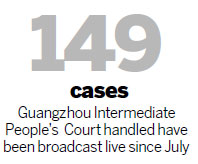White paper aims for better judicial transparency
Updated: 2013-02-20 07:14
By Zheng Caixiong in Guangzhou and Zhao Yinan in Beijing (China Daily)
|
||||||||

Guangdong High People's Court has published a white paper on how the court has dealt with scrutiny from netizens during a number of high profile court cases.
The white paper also explores ways the southern province can make court proceedings more transparent.
Publication of the white paper will help advance judicial reforms and bring court trials under greater public supervision, Zheng E, president of Guangdong High People's Court, said on Tuesday.
"It will certainly help make court trials more open, fair, efficient and honest," Zheng said.
Courts across Guangdong will start to publish all court verdicts online in the coming months, he added.
He urged judges in the province to respect public opinion but not to be influenced by it during trials.
The Guangdong court is the first to publish such a white paper on the Chinese mainland.
The 160,000-character document looks at 15 major court cases the court handled that came under close public scrutiny in 2012, including the iPad trademark dispute between US tech giant Apple Inc and Shenzhen Proview in February last year.
The case was first heard in Shenzhen Intermediate People's Court in February 2011.
The court broadcast live updates on the case, which attracted a great deal of attention at home and abroad.
Apple eventually agreed to pay $60 million to Proview in a court-mediated settlement in July.
Courts in the province have seen the number of cases they handle rise by an average of 5.21 percent a year over the past three years.
Meanwhile, the cases have become more complicated - from divorces and debt cases, to disputes involving distribution of property, shareholdings, succession rights and land acquisition and relocation.
To meet the demands and growing expectations of the public, courts across the province need to further advance reforms and make their work more transparent, Zheng said.
Since July, Guangzhou Intermediate People's Court has been broadcasting live coverage of major trials in partnership with a local media website.
Since July, 149 cases the court handled have been broadcast live, playing a major role in making the court's operations more transparent.
Nanshan district court in Shenzhen also began to publish its verdict online late last year. Meanwhile, media and the public have been able to check court results online and by phone.
The Supreme People's Court in China released a standard for judicial transparency in 2010 and selected 100 pilot courts, which were encouraged to make reforms in improving judicial transparency.
The standard includes requirements of judicial transparency throughout the courts, such as case filing and court hearings. It also has a document that "scores" transparency, so different courts can be graded and compared.
Jiang Ming'an, a law professor at Peking University, said judicial transparency has improved overall, especially since Sina Weibo, a micro-blogging platform, became popular.
"Many courts have opened their own Sina Weibo account and publish information regularly. But I hope the transparency will go deeper and not simply be superficial. It is more important what they publish as opposed to how they publish information," he said.
Contact the writers at zhengcaixiong@chinadaily.com.cn and zhaoyinan@chinadaily.com.cn
(China Daily 02/20/2013 page4)

 In Photos: 7.0-magnitude quake hits Sichuan
In Photos: 7.0-magnitude quake hits Sichuan
 Li Na on Time cover, makes influential 100 list
Li Na on Time cover, makes influential 100 list
 FBI releases photos of 2 Boston bombings suspects
FBI releases photos of 2 Boston bombings suspects
 World's wackiest hairstyles
World's wackiest hairstyles
 Sandstorms strike Northwest China
Sandstorms strike Northwest China
 Never-seen photos of Madonna on display
Never-seen photos of Madonna on display
 H7N9 outbreak linked to waterfowl migration
H7N9 outbreak linked to waterfowl migration
 Dozens feared dead in Texas plant blast
Dozens feared dead in Texas plant blast
Most Viewed
Editor's Picks

|

|

|

|

|

|
Today's Top News
Live report: 7.0-magnitude quake hits Sichuan, heavy casualties feared
Boston suspect cornered on boat
Cross-talk artist helps to spread the word
'Green' awareness levels drop in Beijing
Palace Museum spruces up
First couple on Time's list of most influential
H7N9 flu transmission studied
Trading channels 'need to broaden'
US Weekly

|

|







